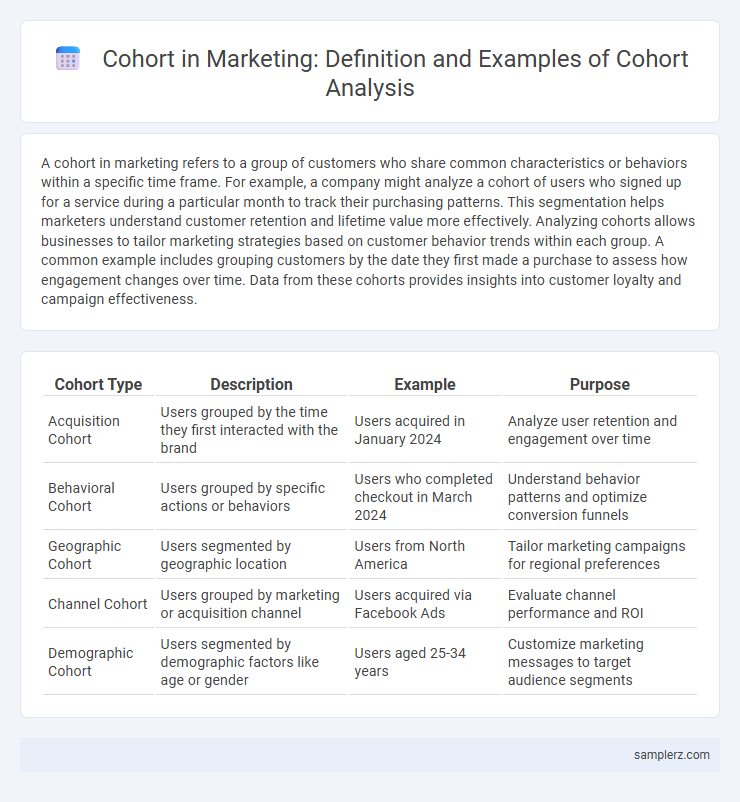A cohort in marketing refers to a group of customers who share common characteristics or behaviors within a specific time frame. For example, a company might analyze a cohort of users who signed up for a service during a particular month to track their purchasing patterns. This segmentation helps marketers understand customer retention and lifetime value more effectively. Analyzing cohorts allows businesses to tailor marketing strategies based on customer behavior trends within each group. A common example includes grouping customers by the date they first made a purchase to assess how engagement changes over time. Data from these cohorts provides insights into customer loyalty and campaign effectiveness.
Table of Comparison
| Cohort Type | Description | Example | Purpose |
|---|---|---|---|
| Acquisition Cohort | Users grouped by the time they first interacted with the brand | Users acquired in January 2024 | Analyze user retention and engagement over time |
| Behavioral Cohort | Users grouped by specific actions or behaviors | Users who completed checkout in March 2024 | Understand behavior patterns and optimize conversion funnels |
| Geographic Cohort | Users segmented by geographic location | Users from North America | Tailor marketing campaigns for regional preferences |
| Channel Cohort | Users grouped by marketing or acquisition channel | Users acquired via Facebook Ads | Evaluate channel performance and ROI |
| Demographic Cohort | Users segmented by demographic factors like age or gender | Users aged 25-34 years | Customize marketing messages to target audience segments |
Understanding Cohorts in Marketing
A marketing cohort consists of customers grouped based on shared characteristics or experiences, such as the month they made their first purchase or the campaign through which they were acquired. Tracking these cohorts reveals patterns in customer behavior, retention, and lifetime value, enabling targeted strategies that improve engagement and ROI. Analyzing purchase frequency and churn rates within cohorts helps marketers optimize campaigns and allocate resources more effectively.
Key Characteristics of Marketing Cohorts
Marketing cohorts are groups of customers segmented based on shared characteristics such as acquisition date, buying behavior, or demographic profiles. Key characteristics include time-bound engagement periods, consistent purchasing patterns, and similar responses to marketing campaigns, enabling precise performance analysis. These cohorts help marketers optimize customer retention strategies by tracking lifetime value and behavior trends over specific intervals.
Demographic Cohort Examples in Campaigns
Demographic cohort examples in marketing campaigns often target age groups such as Millennials, Gen Z, or Baby Boomers to tailor messaging and product offerings effectively. Brands might create specific campaigns for Millennials, emphasizing digital engagement and sustainability, while Baby Boomer-focused campaigns highlight reliability and value. Segmenting by demographic cohorts enables marketers to optimize conversion rates and increase customer loyalty through personalized experiences.
Behavioral Cohorts: Segmenting by Actions
Behavioral cohorts in marketing categorize customers based on specific actions such as purchase frequency, browsing history, or engagement with promotional emails. For example, a cohort of users who made a purchase during a flash sale can be targeted with tailored offers to encourage repeat buying. Tracking these behavioral patterns enables marketers to optimize campaigns and improve customer retention through personalized communication.
Acquisition Cohorts: Measuring Campaign Effectiveness
Acquisition cohorts track groups of customers based on the campaign or channel through which they were acquired, enabling precise measurement of marketing ROI. By analyzing user behavior and retention within these cohorts, marketers identify which campaigns deliver the highest lifetime value and conversion rates. This data-driven approach optimizes budget allocation and enhances targeting strategies for future acquisition efforts.
Retention Cohorts: Tracking Customer Loyalty
Retention cohorts segment customers based on their initial interaction date to analyze repeat purchase behavior and long-term engagement. By tracking metrics like retention rate and customer lifetime value (CLV) over specific periods, marketers identify trends in loyalty and effectiveness of retention strategies. This data-driven approach helps optimize campaigns, personalize communication, and increase customer retention rates.
Cohort Analysis in Email Marketing
Cohort analysis in email marketing segments subscribers based on their sign-up date or first purchase, allowing marketers to track engagement and retention trends over time. For example, a cohort of users who received a welcome email series can be analyzed to measure open rates, click-through rates, and conversion rates across different time intervals. This data-driven approach helps optimize email content and timing to improve customer lifetime value and reduce churn.
Enhancing Personalization with Cohort Data
Cohorts in marketing, such as users who signed up during a specific campaign or those engaging with a product feature within a set timeframe, enable tailored messaging and offers that increase relevance and conversion. Analyzing purchasing behavior within these groups allows marketers to predict future needs and optimize content delivery across channels like email and social media. Leveraging cohort data enhances personalization by segmenting audiences based on shared characteristics, improving customer retention and lifetime value.
Tools for Cohort Analysis in Marketing
Google Analytics offers robust tools for cohort analysis, enabling marketers to track user behavior by acquisition date and segment data based on custom dimensions. Mixpanel provides advanced cohort analysis capabilities with real-time tracking and funnel reports tailored to user engagement and retention metrics. Amplitude's platform specializes in behavioral cohort analysis, highlighting product usage patterns and providing actionable insights to optimize marketing strategies and customer lifetime value.
Case Studies: Successful Cohort-Based Marketing
Successful cohort-based marketing case studies include Airbnb's segmented user groups that tailored messaging based on travel behavior, significantly increasing engagement rates. Spotify analyzed cohorts by user subscription date to personalize playlists and promotions, driving higher retention and subscription upgrades. Facebook's cohort approach tracked advertisers by campaign start date, optimizing ad spending and boosting ROI through targeted insights.

example of cohort in marketing Infographic
 samplerz.com
samplerz.com